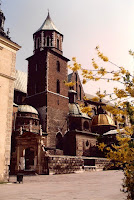Kraków rose to prominence in 1038
when it became the seat of the Polish government under Duke Casimir I of the first
Piast Dynasty. By the end of the
century, it had become the leading city of trade and commerce. The Mongols ravaged the city in 1241 and it
was later rebuilt completely. It
survived two more Mongol onslaughts, thanks to defensive fortifications that
had been built in the wake of earlier attacks.
The last King of the Piast Dynasty, Casimir III the Great, ordered the
building of the Wawel Castle
After a good night’s rest and a
carefully selected kosher breakfast next morning – for pork closely follows God,
Honour and Fatherland in Polish dogma – a few of us history buffs walked down
to the nearby Wawel Castle. A gypsy folk
band playing on a violin, a double bass and an accordion, regaled us with a
rather beat up melody as we headed towards the gateway. The courtyard is surrounded on three sides by
colonnaded galleries, reflecting the Renaissance Style that was in vogue at the
time of the castle’s complete reconstruction by Sigismund I, in the first half
of the 16th century. Of
similar vintage, our Lahore Fort pales in front of Wawel
Castle
While touring the royal apartments,
we noted the considerable distance between the king’s and the queen’s bedrooms
with some amusement, though this was no hurdle for Sigismund I who sired eight
children from two wives! A rich
collection of Flemish tapestries adorn the walls of the king’s bedroom, as well
as the Audience Hall and the Senators’ Hall.
An armoury and a treasury house a rich collection of royal artefacts and,
are reminiscent of the Sikh Collection at the Lahore Fort.
The tour was rounded off with a
short visit to the Wawel Cathedral, which has been the traditional site of
royal coronations and the resting place of Polish heroes. Of the several chapels that are adjuncts to
the cathedral, the Sigismund Chapel stands out for its glittering dome of pure
gold. One is reminded of Sunehri Masjid
in Inner Lahore’s Kashmiri Bazaar, though its domes are of everyday copper.
In
the afternoon, we walked down to the nearby Main
Market Square Jagellonian
University Poland
We were just in time at the Market
Square tower of St
Mary
After a day of riotous sightseeing, the
serene Vistula River meandering around Wawel Castle beckoned our tired eyes for
a mellow glimpse. My friend Asif, ever
eager to appreciate Nature, joined me for an after-dinner walk along the base
of the Wawel Hill which is supposed to house a dragon’s lair. Suddenly, we caught sight of a tongue of
flame lashing out of the mouth of a creature that did seem like a dragon from
afar. Much to our amusement, we saw the
metal sculpture spewing fire every two minutes.
Steeped in myths and legends like all old cities are, we learnt the
story of a rapacious dragon of Kraków, which was slain by a cobbler’s son Skuba, after everyone else had
failed to stop it from gobbling the city’s fair maidens. As a reward, Skuba got the hand of the last
surviving maiden – the king’s daughter.
Of course, they lived happily ever after. Tourists can be so gullible, we thought, but
nonetheless Kraków was doing well at their expense!
While
we were sitting on a bench watching the dragon in its fire-breathing act, we
heard a strange noise that seemed to have threatening overtones. Not far was a crowd of fifty-odd jeering
punks approaching in our direction. As
they got closer, we picked out the beer bottles in their hands. Asif was quick to sense that the situation was
likely to get nasty, so without much ado we got up and scrammed, giving no
chance for a missile to be launched at us.
The
short trip to Kraków was rounded off the next day with a trip to an extra-ordinary place: the Nazi’s infamous WW-II Concentration Camp at Auschwitz. In less than an hour, we had driven right up
to the gate displaying the famous sign, “Arbeit Macht Frei” (work makes you free). Following a group photo at the gate, we were
assigned to a tour guide, one of the Israeli-sponsored college students who volunteer
for such duties during vacations. We
were taken to various internment barracks and some grisly locations like the
gas chambers, crematoriums and firing ranges for summary executions. Roomfuls of exhibits included prisoners’
eyeglasses, shoes, headgear, etc. The camp was one large museum
of human atrocities on an unprecedented scale.
To us, it did not matter if some sceptics questioned the extent of the
holocaust; to the suffering family, one death of its dear one meant the same loss
as did a million deaths to everyone else.
In an unusual gesture, our group laid a floral wreath at the Execution
Wall, which was heartily approved by surprised on-lookers, this being a first
of sorts by Pakistanis.
After the visit to Auschwitz ,
we drove off to Warsaw
During our short stay, we had noted that Poland Lahore Lahore
© KAISER TUFAIL. This is an open-access article
published under the terms and conditions of the Creative Commons Attribution
Licence, which permits unrestricted use, distribution, and reproduction in any
medium, provided the original author and source are
credited.
Picture credit: Planty Park (first picture) by Tadeusz Weise.
This article
was published in the daily newspaper The News International, on 22 July, 2012.





